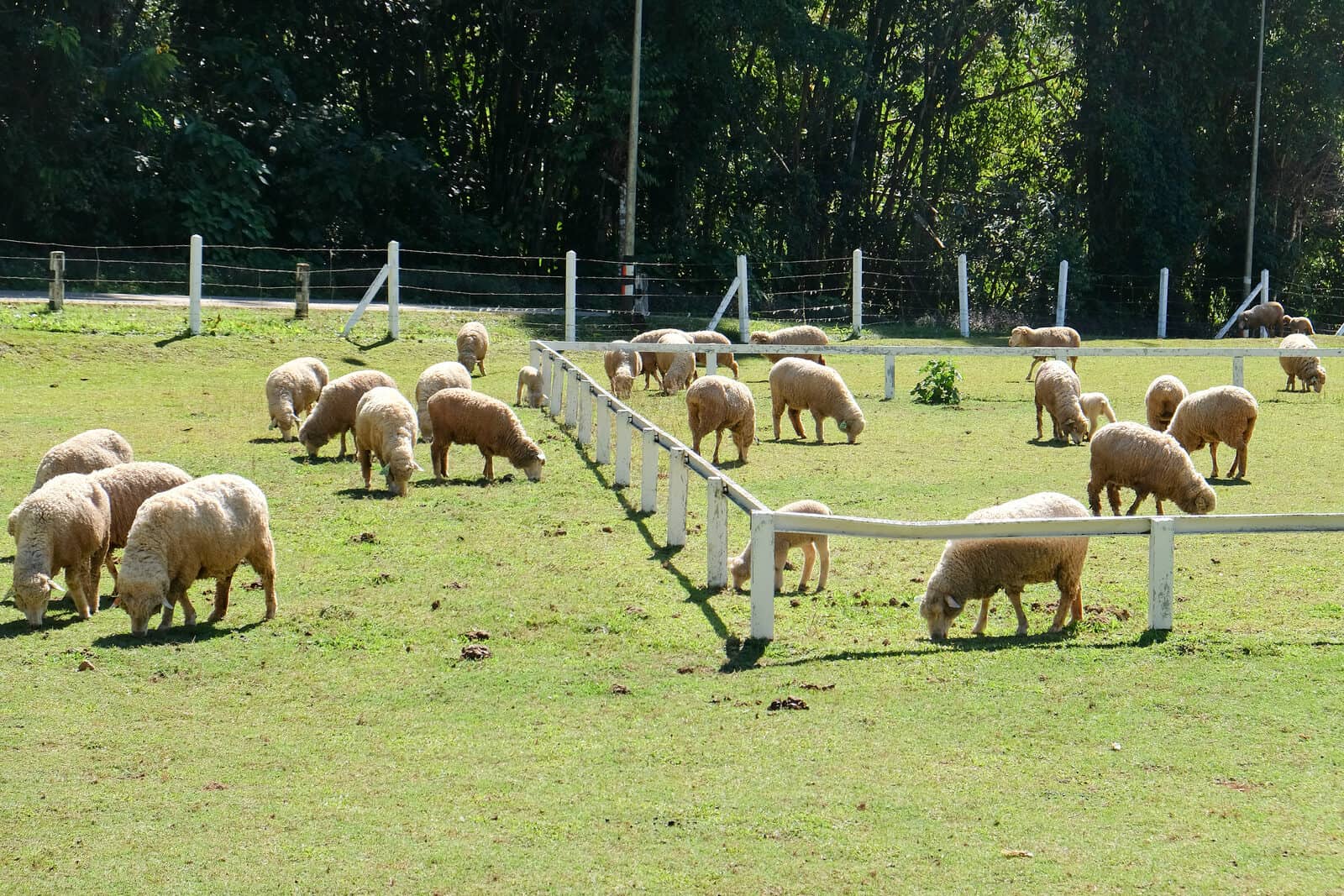Learn how many sheep per acre you can successfully raise. The size of your flock depends on how much land you have. There is an inclination to overestimate your property’s carrying capacity, particularly if you are a small acreage landowner. Farmers are optimists. They will make decisions based on days when their crops are thriving, forgetting the sheep will be there throughout the year.
Sheep need enough pasture to meet their nutritional needs and space to graze for thriving. On the other hand, farm owners like to know that their land is not lying idle when it can be productive. Balancing a sustainable flock with using your land effectively can be tough.
We’ve done some research to help you figure out the maximum number of sheep per acre. Keep reading for tips on establishing a sustainable stocking rate for your property.
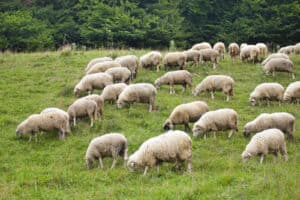
How Many Sheep Per Acre
If you use the same acre of land throughout the year, its recommended stocking rate is 2 sheep. This may seem restrictive, but the forage produced by your typical acre will not sufficiently nurture more than two sheep for an entire year or through the grazing season.
You can also stock from 6 to 10 sheep per acre, or 15 if your flock is still young. This requires your forage production to be extra lush and fast-regenerating. Proactivity might also give you the same results; you can fill the nutritional deficit with extra roughage like hay or practice regular field rotation to allow regeneration.
Differences in the environment can cause variations in carrying capacity, sheep’s size, and the specific breeds you rear on your property. The above are mostly ballpark figures because, in reality, no single sheep stocking rates per acre will be ideal for all climates, pasture conditions, or sheep breeds. The optimal number of sheep per acre is unique for each property and sheep enterprise.
Determining Your Land’s Optimal Stocking Rate
Grass and other fodder grow best in spring but are limited during winter, affecting sheep’s access to food. If you base your estimation on the amount of cover in spring, your land will not be able to sustain your ewes, rams and lambs in the colder months when vegetation is scarce. You need to factor in the whole year because the sheep are permanent farm residents.
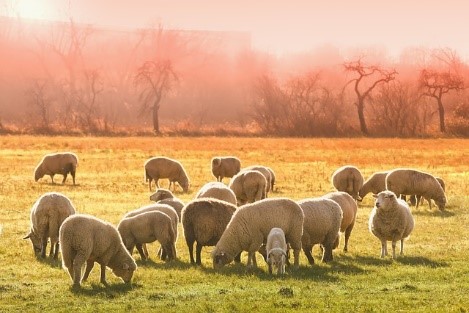
It is also good practice to encourage the sheep to eat more during spring to bulk up in preparation for going to the market or the slaughterhouse. This is why experienced sheep farmers prefer to operate slightly below their properties’ stocking capacity. Exceeding it will strain both farm and sheep, and you still won’t be able to reap the benefits of healthy sheep.
It is advisable to start with a smaller number of sheep to test your fodders’ resilience and gradually increase the number to the maximum of ten if the acre is capable.
Calculating the Stocking Rate
While it is not an exact science, there is a formula that you can use to balance your sheep with your forage for the entire year through the different seasons.
This formula assumes that livestock needs to consume three percent of their weight in forage daily. If we factor in wastage through trampling at 0.5% and a buffer of 0.5%, the recommended daily forage utilization should be four percent of their weight.
You will also need to establish the average yield of your pasture per acre. This can be challenging if you are just starting out, but your local Natural Resource Conservation Service (NRCS) office should have average yield estimates for the area. This information is accessible to the public. Use this rotational grazing calculator for sheep:
Number of Sheep Per Acre = Total Acreage of the Property X Average Yield Per Acre
4% of the Average Sheep Weight X 365 Days
This formula gives you the maximum number of sheep the whole property can accommodate. You can always stock fewer sheep to allow for the hyperactive ones and the abnormally large flock members with larger appetites.
Now that we have a rough idea of how many sheep we can raise per acre, we can familiarize ourselves with the variables that impact these figures from one farm to another.
Factors That Influence the Ideal Number of Sheep Per Acre of Pasture
Size and Breed of Sheep
Smaller sheep require less food compared to larger ones, impacting their dietary needs. You can sustain more lambs per acre than fully grown sheep. The same logic applies to male versus female sheep. Rams are bigger and more aggressive than ewes, and ram lambs grow faster than ewe lambs.
Rams, therefore, feed more than ewes and will require more forage space. The same acreage of land will accommodate more ewes than rams. Rams should also be separated on principle as they are territorial and competitive.
The breed of sheep also significantly influences the amount of space required to sustain them. If your goal is to maximize the number of sheep on your property, you should consider raising smaller sheep breeds. They will utilize your pasture most efficiently.
If we apply the 4% rule, Babydoll sheep will only grow to a maximum of 120 pounds and require approximately 4.8 pounds of pasture. On the other hand, a wooly Lincoln sheep ram can grow to 350 pounds. A wool sheep requires a daily weight of 14 pounds of fodder. This is almost three times the Babydoll’s needs. Learn about Suffolk sheep.
An acre that can sustain up to ten small-breed sheep might only be sufficient for two large-breed sheep. Other intermediary breeds will fall in between these figures. Learn about the size difference between lamb vs sheep.
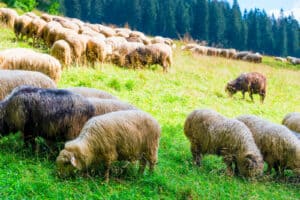
Type of Vegetation on the Farm
Sheep are natural grazers and have been historically used to keep lawns and yards tidy before the lawnmower became popular. They need to eat most of the day (more than eight hours) and will forage on grass, shrubs, or hay for sustenance.
A fully grown sheep can devour up to 4.5 pounds of grass every day. Although they are almost the same size as goats, they rarely browse and need more grass to graze.
We have a more comprehensive comparison which explains the difference between sheep and goats if you have yet to decide between the two.
Different grasses provide varying amounts of energy, minerals, and protein. They also have unique capacities to survive different seasons and environments. Farms with more grasslands available for their sheep enjoy longer grazing periods throughout the year. Diversifying the type of forage helps maintain food availability throughout the year.
You can have Timothy grass for its high energy yield and make up for its short growth cycle with Kentucky Bluegrass that can survive through wet and dry conditions, then top it up with Orchard grass which is lush and thick. Such combinations ensure the abundance and sustainability of pasture.
Climate Where the Farm Is Located
Some regions experience extreme weather conditions, while others only have mild changes. Long winters coupled with heavy snow lead to scarcity of vegetation for extended periods. This means there is less food to go around, so stocking capacity will be reduced.
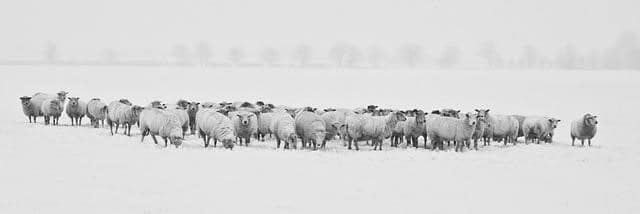
Locations with shorter winters allow vegetation to grow for longer periods, and some species will even survive the mild winter. The consistent availability of food enables you to rear a larger sheep flock.
For example, a sheep farmer in Texas with milder winters or in Missouri with shorter winters will have a higher stocking capacity than a sheep farmer in New York. Learn about keeping Icelandic sheep and another hardy breed such as Texel sheep. Icelandic sheep and Texels are very resilient and adaptable.
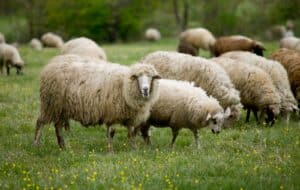
Quality of Soil on the Land
Fodder gets its nutrients from the soil on which it grows. If the soil on the acre of land in question is nutrient-rich, the vegetation will be thicker and more nutritious. This increases the sustainable stock level of the acre, enabling the farmer to raise more sheep on it.
You will need more land for raising sheep of the same number if the soil’s nutritional content is low.
Our Take on How Many Sheep Can You Have Per Acre
It is good to keep the flock manageable for health and logistical reasons. Six to 10 sheep per acre is a reasonable standard, but each farm has its own unique conditions for raising sheep. Understanding what affects stock levels is more important than having set numbers. The information enables you to get the most out of your property and pasture.
Sheep are considered a suitable option for farming due to their ease of care, adaptability to small flocks, and potential return on investment. Additionally, raising meat sheep breeds can provide a sustainable source of meat regardless of flock size.
Raising meat sheep breeds can offer a sustainable source of meat, whether you’re tending to a few sheep or managing a larger flock.
In addition to meat, milk, and wool from sheep, some breeds have fat tails. You can use the fat from the tails from fat tailed sheep in cooking.
Learn how to shear a sheep to keep them cool in the summer and to maximize wool breeds’ value. If you are raising dairy sheep, learn best practices for how to milk a sheep.
- Meat sheep breeds
- Sheep names for your flock
- Learn if Rambouillet sheep are a good fit for your land.

